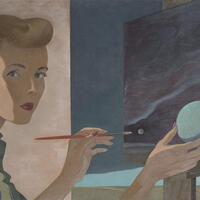More about Isamu Noguchi
Works by Isamu Noguchi

Contributor
Isamu Noguchi’s entire life was like doing to splits over the Pacific Ocean with one foot in Japan and the other in America.
Noguchi was a beautiful man with eyes that melt your heart like a Dalí clock and he was made up of two combating worlds - his art acting as the bridge. He was born in 1904 to the Japanese poet, Yonejirō Noguchi and the American writer, Léonie Gilmour. He was a love child and as such was never taken care of by his father. He and his mother moved to Japan when Noguchi was 2 and gave the whole family thing a try but soon found out that Yonejirō had another set of mouths to feed with a new lady. So Noguchi and his mom moved around Japan until she sent him to school in Rolling Prairie, Indiana which is just like Japan except for everything about it. The 13-year-old Noguchi felt totally abandoned and lost but was taken under the wing of Edward Rumely, the founder of the school. Finally, a father-figure!
Noguchi told Rumely about his interest in art and he hooked Noguchi up with Gutzon Borglum, the creator of Mount Rushmore. Unfortunately, Borglum told Noguchi he had no talent so Noguchi enrolled in pre-medical school at Columbia University while taking night classes at Leonardo Da Vinci Art School. Within three months he had his own exhibit and within two year he won the Guggenheim Fellowship explaining, “In his letter of application, [that] he proposed to study stone and wood cutting and to gain 'a better understanding of the human figure.'” He was 22 so of course he wanted a better understanding of the human figure… Noguchi, you dog.
Off to Paris he went and became the assistant of Constantin Brâncusi and met people like Alexander Calder. He traveled extensively for the next two decades making art and meeting people along the way. He took a road trip with his good friend Arshile Gorky across the country and had a love affair with Frida Kahlo, after which Diego Rivera threatened to kill him. He voluntarily went into a Japanese internment camp in order to encourage art and community inside the camp but was not trusted by anyone. This led to a full-on investigation as they thought Noguchi was a spy. No good deed, am I right?
His life timeline sounds a little like a bucket list and his art has been called, “landmarks of 20th century art,” which is pretty chill. Overall, he was probably one of the best sculptors to ever live. Suck on that Gutzon Borglum.
Sources
- "Proposal to the Guggenheim Foundation (1927)". The Noguchi Museum. Retrieved on October 18, 2006. Archived October 3, 2006, at the Wayback Machine.
- BRENSON, MICHAEL. "Isamu Noguchi, The Sculptor, Dies At 84". Nytimes.com. N.p., 1988. Web. 24 Mar. 2017.
- "Meet The Author: Listening To Stone: The Art And Life Of Isamu Noguchi By Hayden Herrera". YouTube. N.p., 2015. Web. 24 Mar. 2017.
Featured Content
Here is what Wikipedia says about Isamu Noguchi
Isamu Noguchi (野口 勇, Noguchi Isamu;
Japanese: [noꜜgɯtɕi isamɯ],
English: /nəˈɡuːtʃi/; November 17, 1904 – December 30, 1988) was an American artist, furniture designer and landscape architect whose career spanned six decades from the 1920s. Known for his sculpture and public artworks, Noguchi also designed stage sets for various Martha Graham productions, and several mass-produced lamps and furniture pieces, some of which are still manufactured and sold.
In 1947, Noguchi began a collaboration with the Herman Miller company, when he joined with George Nelson, Paul László and Charles Eames to produce a catalog containing what is often considered to be the most influential body of modern furniture ever produced, including the iconic Noguchi table which remains in production today. His work is displayed at the Isamu Noguchi Foundation and Garden Museum in New York City.
Check out the full Wikipedia article about Isamu Noguchi















